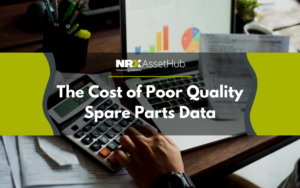Having the language to describe something complicated can be very empowering. This is what makes a spare parts dictionary so useful and important. Searching for and identifying spare parts becomes much easier when you have the language to understand what you’re looking for and to know when you’re looking at it. Even better is having a standardized language. This way, the understanding of the spare parts data you need is shared no matter who you’re talking to or where you’re searching for information. We’ve discussed spare parts dictionaries on this blog before. To recap, a spare parts dictionary is a naming system which classifies the characteristics of a spare part, enabling materials to be organized by their type, class, or characteristics according to standard naming conventions. But how exactly does a dictionary do that?
Nouns, modifiers, and attributes
Each organization’s approach to their spare parts dictionary may be slightly different depending on the needs of their EAM or CMMS systems, but a commonly used format for naming spare parts is the noun-modifier-attribute model.
This means that a spare part is identified by a primary noun that describes it broadly (for instance, “bearing”), followed by a modifier that describes that noun more specifically (for instance, “ball”), followed by an attribute of the part that even more specifically describes it (for instance, its inner diameter).
Try to imagine this classification system on a broader scale, in which a noun and each modifier may have multiple attributes, creating a hierarchy that can describe many different parts in many different ways. Typically, standardization also comes into play, with information like names of manufacturers of parts numbers corrected and made uniform to create a consistent naming convention throughout your EAM or CMMS system. Ultimately, this whole process serves to make your spare parts data more efficiently searched and understood, increasing wrench time for workers and giving them the knowledge to do their jobs more effectively.
Spare parts dictionaries start with a cleanse
Implementing your spare parts dictionary can be an integral part of a good materials data cleanse. However, with hundreds or thousands of parts to classify, creating a dictionary that best suits the needs of your organization can be intimidating. After all, some EAM solutions out there come with helpful and flexible templates for classifying your spare parts data, while others come as completely blank slates that leave the customization of your classification system entirely up to you. If you’d like to learn more about the best practices for a complete materials cleanse, check out one of our resources below, or book a demo with us to begin visualizing what a spare parts dictionary could look like for you!
Six Steps to Cleansing Spare Parts Data

Knowing Your Spare Parts Dictionary From A to Z

The Cost of Poor Quality Spare Parts Data

Share this article

